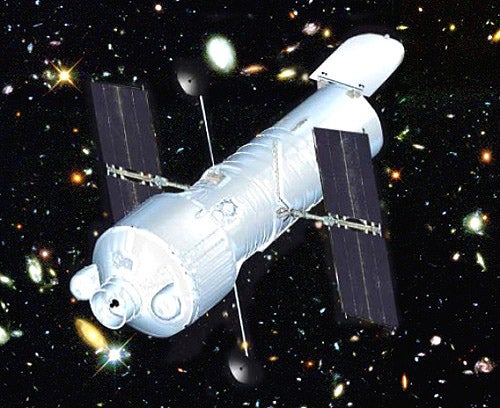The Hubble Space Telescope, it seems, just can’t catch a break. Sooner or later, aging batteries and failing gyroscopes will put a stop to the tremendous flow of science from Hubble, which astronomers have lauded as the most productive telescope since Galileo’s.
NASA canceled the final shuttle servicing mission last year, citing safety considerations following the Columbia tragedy in 2003. Then, the space agency became intrigued by the possibility of repairing Hubble with a robot. Both a National Research Council panel and the world’s largest group of astronomers back servicing the telescope by some means — preferably with the shuttle. But sources in the White House have indicated that NASA’s 2006 budget, to be unveiled next week, will not include the estimated $1.5 billion for either repair option.
Now, an international team led by Johns Hopkins University astronomers suggests an alternative: create a new space telescope, called the Hubble Origins Probe (HOP), that would carry instruments built for the canceled servicing mission. “Though we support any option that will maintain the Hubble mission, the Hubble Origins Probe is the best choice not only for continuing that tradition of discovery, but also for taking it one step further,” said Colin Norman, one of the team leaders, in testimony before the U.S. House of Representatives Committee on Science yesterday.
HOP would replicate design of the original Hubble but use a much lighter mirror and a modern spacecraft. The new mirror would not contain Hubble’s mission-threatening optical flaw, which astronauts fixed in 1993 during the telescope’s first servicing mission by installing “contact lenses.” HOP would include two instruments destined for Hubble that have been built already — the Cosmic Origins Spectrograh (COS) and Wide Field Camera 3 (WFC3).
HOP can be developed quickly at significant savings and low risk, according to Norman, by replicating a successful design and using existing instruments. The spacecraft bus, which provides power, data handling, pointing control, and communications, is based on the Spitzer Space Telescope’s. One of HOP’s fine guidance sensors, which are crucial for tracking cosmic targets, will come from Hubble’s own spare parts, but two others will be designed using modern technology.
The new spacecraft will sport a “deorbit module,” a rocket motor that will allow the telescope’s safe entry into the atmosphere at the end of its working life. Hubble lacks such a rocket, and some future spacecraft must attach one after the spacecraft dies.
“In the context of the astronomical roadmap, our goal with HOP is to first repair the bridge broken by the Columbia tragedy, and then drive over that bridge and explore current territory planned on the roadmap for Hubble science,” Norman said. Plans call for the new telescope to be launched on an Atlas 521 rocket into low Earth orbit in 2010.
A new camera, dubbed the Very Wide Field Imager (VWFI), would be built in collaboration with Japanese partners, who would underwrite the cost. Saku Tsuneta of Japan’s National Astronomical Observatory leads the development team.
“The scientific enhancement of the mission comes from the fact that the field of view of the VWFI is 17 times that of the Advanced Camera currently flying on Hubble, and the VWFI is 3 to 4 times more sensitive at critical wavelengths,” explained Norman. “We will use this powerful new capability to detect thousands of transits by planets … opening an exciting era of planetary demographics, survey for hundreds of … type Ia supernovae to investigate the nature of dark energy, and to … measure the large-scale distribution of dark matter.”
The telescope’s design could host one additional instrument, possibly a spectrograph contributed by European and Australian partners.
“HOP can address three of the most central intellectual issues of our age: the nature of dark energy, the nature and distribution of dark matter, and the prevalance of planets, including Earths, around other stars,” Norman said.
“The decision before us is obvious. We must continue with the Hubble adventure to explore these great questions further, to understand more fully our remarkable universe and our place in it. We must do this with intense determination and energy, and thus continue to inspire new generations with the wonder and thrill of exploration and discovery,” he concluded.










